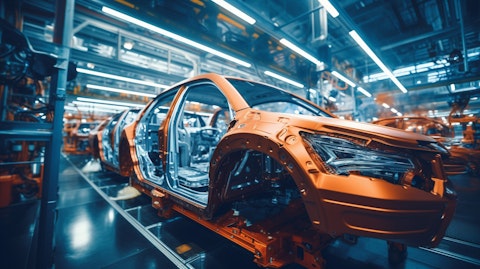China Automotive Systems, Inc. (NASDAQ:CAAS) Q2 2025 Earnings Call Transcript August 13, 2025
Kevin Theiss: Thank you, everyone, for joining us today. Welcome to China Automotive Systems 2025 second quarter conference call. Joining us today are Mr. Jie Lee, Chief Financial Officer of China Automotive Systems. He will be available to answer questions later in the conference call with the assistance of translation. Before we begin, I will remind all listeners that throughout this call, we may make statements that may contain forward-looking statements within the meaning of the Private Securities Litigation Reform Act of 1995. Forward-looking statements represent the company’s estimates and assumptions only as of the date of this call. As a result, the company’s actual results could differ materially from those contained in the forward-looking statements due to a number of factors, including those described under the heading Risk Factors, Results of Operations in the company’s Form 10-K annual report for the year ended December 31, 2024, as filed with the Securities and Exchange Commission and in other documents filed by the company from time to time with the Securities and Exchange Commission.
Any of these factors and other factors beyond our control could have an adverse effect on the overall business environment, cause uncertainties in the regions where we conduct business, cause our business to suffer in ways that we cannot predict and materially and adversely impact our business, financial condition and results of operations. A prolonged disruption or any unforeseen delay in our operations of the manufacturing, delivery and assembly processes within any of our production facilities could result in the delays in shipments of products to our customers, increased costs and reduced revenue. Company expressly disclaims any duty to provide updates to any forward-looking statements made in this call, whether as a result of new information, future events or otherwise.

On this call, I will provide a brief overview and summary of the second quarter 2025 results for the period ended June 30, 2025. Management will then conduct a question-and-answer session. The 2025 second quarter results are unaudited and are reported using U.S. GAAP accounting. For the purposes of our call today, I’ll review the financial results in U.S. dollars. We will begin with a review of some of the quarterly business highlights, recent dynamics of the Chinese economy and automobile industry and our market position. Our sales increased by 11.1% year-over-year to $176.2 million in the second quarter of 2025 compared to $158.6 million in the second quarter of 2024, an increase compared with $167.1 million in the first quarter of 2025. Total sales of electric power steering systems, EPS, increased by 31.1% year-over-year to $72.9 million as our sales mix continues to shift to higher technology products.
Our Henglong KYB subsidiary achieved 26% year-over-year growth of its EPS products in the second quarter of 2025. Total EPS products were 41.2% of total sales for the 3 months ended June 30, 2025, versus 35.1% for the same quarter in 2024. Our steering subsidiary, Henglong, which produces traditional hydraulic steering systems for the Chinese passenger vehicle market, reported a 4.2% year-over-year sales increase to $83.4 million in the second quarter of 2025. Sales by Jiulong’s commercial vehicle steering products increased by 25.6% year-over-year in the second quarter of 2025. Tax incentives, subsidiaries for scrapping older vehicles and lower interest rate financing are among the government incentives to support the purchases of automobile vehicles in China for 2025.
Additionally, local and private incentives may also aid buyers. North American sales increased by 14.9% year-over-year to $30.8 million, primarily due to higher sales to Stellantis. Our Brazilian sales increased by 49.4% year-over-year, mainly due to higher demand by Stellantis also. Brazilian sales represented 10.1% of total sales in the second quarter of 2025. Combined, North and South American sales have risen to approximately 27.5% of total sales in the 2025 second quarter. For the macro economy, Chinese GDP was 5.2% year-over-year in the second quarter of 2025, a slight decrease from the 5.4% in the first quarter of 2025. As the passenger vehicle and commercial vehicle markets in China are our largest markets, their status can have direct impact on our sales.
Q&A Session
Follow China Automotive Systems Inc (NASDAQ:CAAS)
Follow China Automotive Systems Inc (NASDAQ:CAAS)
Receive real-time insider trading and news alerts
According to statistics from the China Association of Automobile Manufacturers, CAAM, total vehicle unit sales increased by 11.4% year-over-year in the first half of 2025. Passenger vehicle unit sales grew by 13% year-over-year and commercial vehicle sales increased by 2.6% year-over-year in the first 6 months of 2025. Gross profit increased by 4.2% in the second quarter of 2025. Operating expenses were well controlled and declined by $2.2 million in the second quarter of 2025 compared with the 2024 second quarter. R&D expenses were stable at $8.1 million in the second quarter of 2025. We continue the development of our hydraulic and EPS products, especially our R-EPS product line. Income from operations rose by 20.2% to $13 million. Income tax expense was $4 million for the second quarter of 2025 as compared to $2.1 million for the 2024 second quarter.
The increase in income tax is due to higher income before income tax expenses of $15.1 million and expected higher annual effective tax rate in 2025 based on the latest annual forecast as compared to 2024. Net income attributable to parent common shareholders per diluted share was $0.25 versus $0.24 in the year ago second quarter. Net cash provided by operating activities rose by almost $40 million year-over-year to $49.1 million for the first 6 months of 2025. Total cash, cash equivalents plus cash and short-term investments were $135 3 million or approximately $4.48 per share at June 30, 2025. Our second-generation IRCB that’s intelligent electrohydraulic circulating ball power steering for use in heavy-duty vehicles that use both hydraulic power and electrical controls is now in mass production in China.
Following the IRCB’s outstanding performance and cost efficiency, new orders in July by customers set a new record in the power steering industry for the ramp-up to mass production. As China’s first IRCB compatible system with the L2+ assisted driving. This system utilizes cutting-edge electrohydraulic control technology to achieve internationally leading benchmarks in steering accuracy and response speed. By optimizing energy consumption, it is projected to reduce operational costs by nearly RMB 36,000 per vehicle annually. In our first 6 months of 2025, our R-EPS system steering product developed for Nanjing Iveco also entered mass production and is capable of performing autonomous driving functions such as automatic parking, lane keep assist, lane follow assist and also in the first 6 months of 2025, our Shashi Jiulong Power Steering gears company, Shashi Jiulong subsidiary won customer awards and accolades from 2 major commercial vehicle OEMs, Beiqi Foton Motor and Shaanxi Automobile Heavy Truck.
Given our growing international sales, the Board of Directors and management has decided to begin the process to change our corporate registration from the state of Delaware to the Cayman Islands. We believe this change will save significant costs, require less regulatory reporting and allow management to concentrate on improving operations, sales and penetrating our growing international markets. The success of our R&D technology projects has provided state-of-the-art steering products. Our large diverse product portfolio provides solutions for the largest vehicle global OEMs and provides the mean to access more international markets to enhance our growth. Now let me go over the financial results in the second quarter of 2025. Net sales increased by 11.1% year-over-year to $176.2 million compared to $158.6 million in the second quarter of 2024.
Net sales of traditional steering products and parts increased slightly year- over-year to $103.3 million in the second quarter of 2025. Net sales of EPS products rose 31.1% year-over-year to $72.9 million from $55.6 million for the same period in 2024. EPS product sales grew to 41.4% of the total net sales for the second quarter of 2025 compared to 35.1% for the same period in 2024. Our subsidiary Jiulong sales of commercial vehicle steering systems rose by 25.6% to $23.5 million compared with $18.7 million for the second quarter of 2024. Sales to North American customers increased by 11.8% to $30 million compared to $26.8 million in the second quarter of 2024. North American sales increased primarily due to improved demand by one customer.
Sales in Brazil were 49.4% higher in the second quarter of 2024 to $17.9 million from $12 million in the second quarter of 2024. Gross profit grew by 4.2% year-over-year to $30.5 million from $29.3 million in the second quarter of 2024. Gross profit margin decreased to 17.3% in the second quarter of 2025 from 18.5% in the second quarter of 2024. The decrease in gross profit margin was mainly due to an increase in tariffs and a product mix change from increased sales portion of relatively lower-margin products. Gain on other sales was $0.5 million in the second quarter of 2025 compared to $1.7 million in the second quarter of 2024. Selling expenses of $4.5 million in the second quarter of 2025 were consistent with the second quarter of 2024.
Selling expenses represented 2.6% of net sales in the second quarter of 2025 compared to 2.9% in the second quarter of 2024. General and administrative expenses, G&A decreased to $5.4 million compared to $7.4 million in the second quarter of 2024, primarily due to decreased business taxes and surcharges. G&A expenses represented 3.1% of net sales in the second quarter of 2025 compared to 4.7% of net sales in the second quarter of 2024. Research and development expenses, R&D, were stable at $8.1 million in the second quarter of each year. R&D expenses represented 4.6% of net sales in the second quarter of 2025 compared to 5.2% in the second quarter of 2024. Research and development programs include, but are not limited to electric power and hydraulic steering systems, automotive intelligence and software technologies, automotive electronics, high polymer materials and manufacturing technologies.
Other income was $1.1 million for the second quarter of 2025 compared to $1.7 million for the 3 months ended June 30, 2024. Income from operations rose by 20.2% to $13 million in the second quarter of 2025 from $10.8 million in the second quarter of 2024. The increase was primarily due to higher sales. Interest expense was $0.3 million in the second quarter of 2025 compared to $0.2 million in the second quarter of 2024. Net financial income was $1.3 million in the second quarter of 2025 compared to net financial expense of $0.7 million in the second quarter of 2024. The increase in net financial income was primarily due to an increase in the foreign exchange gain due to foreign exchange volatility. Income before income tax expenses and equity and earnings of affiliated companies was $15.1 million in the second quarter of 2025 compared to income before income tax expense and equity and earnings of affiliated companies of $11.7 million in the second quarter of 2024.
The change in income before income tax expense and equity in earnings of affiliated companies was mainly due to higher income from operations in the second quarter of 2025 compared with last year’s same quarter. Income tax expense was $4 million in the second quarter of 2025 compared to $2.1 million for the second quarter of 2024. The increase in income tax expense was primarily due to a higher income before income tax expenses and higher expected annual effective tax rate in 2025 based on the annual forecast as compared to 2024. Net income attributable to parent company’s common shareholders was $7.6 million in the second quarter of 2025 compared to net income attributable to parent company’s common shareholders of $7.1 million in the second quarter of 2024.
Diluted earnings per share were $0.25 second quarter of 2025 compared to $0.24 in the second quarter of 2024. The weighted average number of diluted common shares outstanding was 30,170,702 in the second quarter of 2025 compared to 30,185,702 in the second quarter of 2024. 6 months of 2025, net sales increased by 15.2% year-over-year to $343 million in the first 6 months of 2025 compared to $298 million in the first 6 months of 2024, primarily due to increased sales of EPS systems. 6 months gross profit increased by 10.8% year-over- year to $59.1 million from $53.4 million in the corresponding period last year. 6 months gross profit margin was 17.2% compared with 17.9% in the first 6 months of 2024. Gain on other sales was $1.6 million in the first 6 months of 2025 compared to $2.2 million in the corresponding period last year.
Income from operations increased by 5.7% year-over-year to $21.6 million in the first 6 months of 2025 from $20.5 million in the first 6 months of 2024. Net income attributable to parent company’s common shareholders was $14.7 million in the first 6 months of 2025 compared to net income attributable to parent company’s common shareholders of $15.4 million in the corresponding period in 2024. Diluted earnings per share in the first 6 months of 2025 were $0.49 compared to diluted earnings per share of $0.51 in the first 6 months of 2024. Balance sheet items. Cash, cash equivalents and short-term investments were $135.3 million or approximately $4.48 per share as of June 30, 2025. Net working capital was $170.9 million. Total accounts receivable, including notes receivable, were $294.2 million.
Accounts payable, including notes payable, were $269.6 million and short-term loans were $71.9 million. Total parent company stockholders’ equity was $366.4 million as of June 30, 2024, compared to $349.6 million as of December 31, 2024. Additionally, net cash provided by operating activities of $49.1 million in the first 6 months of 2024. We invested $18.5 million in the capital expenditures in the first half of 2025 as we continue to invest in our R&D and production capabilities. The business outlook. Management has raised revenue guidance for the full fiscal year 2025 to $720 million. This target is based on the company’s current views on operating and market conditions, which are subject to change. With that, operator, we are ready to begin the Q&A.[ id=”-1″ name=”Operator” /> [Operator Instructions] Your first question for today is from [ Jonathan Neets ], an individual investor.
Unknown Shareholder: My question is why has the income tax rate increased in 2025?
Jie Li: [Foreign Language] So there’s — the increase of the tax is due to 2 factors. One is the pre-tax profit, profit before tax has gone up as the overall revenue and it has increased. And the other reason is the tax rate has slightly ticked up. And last year, there was a $1.5 million tax adjustment and — which affected in last year’s tax provision. And this year has a different effect, and that’s overall affecting the tax — total tax provision. [ id=”-1″ name=”Operator” /> Your next question for today is from [ Michael Sitter ], an individual investor.
Unknown Shareholder: I have a question about R&D. It’s in the 2025 second quarter, why was R&D flat at $8.1 million? And what’s the outlook for R&D spending?
Jie Li: [Foreign Language] So Q2, yes, you’re right. In the first quarter — in the second quarter, our revenue has increased, as you can see, revenue increased by 11% but R&D during the same quarter was relatively flat. The reason being during the first quarter, we actually was R&D expenses was a little bit overspent. It increased on a year-over-year basis during the first quarter was increased by — I mean, $3.4 million. That’s about 64% year-over-year increase. That’s part of the reason we didn’t have to increase as much during the second quarter. On the first half perspective, first half the R&D expense is about $16.8 million versus last year same period, $13.5 million. So that R&D expense will continue to invest in the future technology, whether it’s driverless technology or the different type of steering product going to electric vehicle.
So we’re very committed to long-term investment into R&D. Yes. On a full year basis, we’re expecting $32 million to $35 million on R&D expenses. That’s about 5% of total revenue. 80% of our R&D expenses is going to EV-related product, the steering product for the EV sector, including R-EPS and all the kind of product and our customers are sending orders. So overall, R&D is on track.
Unknown Shareholder: Okay. I have a follow-up question, which is, given the strong electric vehicles in China, how much of the current R&D spending is for new energy technologies? And for which products are these new energy technology is for?
Jie Li: [Foreign Language] So 80% of our R&D expenditures are going to the EV. As you know, in China right now, every 2 cars sold in the market, 1 of every 2 cars is EV. So the EV penetration is very large, and they will most likely remain at this level, if not increasing. And so that’s why our product portfolio had to also need to be adjusted to meet the demand. [ id=”-1″ name=”Operator” /> Your next question for today is from Gary Nash, a private investor.
Gary Nash: With sales in Brazil rising by almost 50% in the second quarter, what is the capacity utilization and need for more capital investment?
Jie Li: [Foreign Language] Yes, we’re very pleased and very proud of our growth in the market of Brazil. It’s not only growing at a very rapid pace, like 50% year-over-year. But also, now it’s accounting it crossed the threshold of 10% of total revenue for our overall company. So it’s very exciting about the Brazilian market. In terms of your question on capacity utilization, we right now have run on 3 production lines in Brazil facility. And the utilization is about 90%. We have experienced some — a bit of a bottleneck on the production process, and that has been solved. And so — and in addition to that, we are going to add another production line. So sometime by the end of this year, we’ll have 4 production line. The new line is EPS product, electric power steering product.
So we’re going to have 4 production lines in Brazil alone. Total CapEx, as you asked, will be around $3.5 million. [ id=”-1″ name=”Operator” /> [Operator Instructions] Your next question is from [ Kevin Sies ].
Unidentified Analyst: I had a question from an investor, and he wanted to know a comment, please, that the company is buying back shares and then issuing options to management. And he’d like to get some clarification on that.
Kevin Theiss: So first, this question that you received on the e-mail.
Unidentified Analyst: Was a conversation that he had with me.
Kevin Theiss: Okay. So his question is the company has been buying back shares and also issued options to management team.
Unidentified Analyst: That’s right. He would just like to have a comment from management.
Jie Li: [Foreign Language] So to answer this question, yes, it’s a very good answer. Here’s the answer for the question. The company buyback shares because company see the stock is undervalued or grossly undervalued. And they want to utilize the cash on the book to create some shareholder value. And it’s part of shareholder return program like any other companies. When you see the stock price dip below intrinsic value, you buy the stock. Now on the stock option plan to issue to give to management team, it’s part of the incentive plan to incentivize middle operational management or even senior management to continue to execute the game plan to support the company’s long-term growth, including a number of strategic initiatives from R&D to partnerships.
And so these are critical tools to — for a company to reward to award key employee and also attract talent to join the company. So this is no difference. This practice doing in CAAS is no difference. Other things are happening with Google, [Technical Difficulty] Amazon, it’s exactly the same thing. The U.S. company are incentivized their employee and attracting talent. And at the same time, they’re using their strong cash flow — free cash flow to buyback shares. [ id=”-1″ name=”Operator” /> [Operator Instructions]
Unidentified Analyst: Okay. So I have another question then. Can you discuss the move to the Cayman Islands and what advantages you see to the company and also to the shareholders from this move?
Jie Li: [Foreign Language] Okay. Good. Yes, this is a very good question we received from a few shareholders regarding the redomicile to Cayman Island. This move is mainly for the purpose of reducing the overall cost of being a listed company. As you know, right now, since we are a U.S. company, we have to do a quarterly filing 10-Qs and annual report and 10-Ks. So there are tremendous amount of saving if we move into this new structure, we’re still reporting, but the overall cost of reporting is a lot lower as a foreign company. And we are — most of our operations outside the U.S. anyway. That’s one. And two is we — even this move domiciled to Cayman doesn’t change the main things we are still listed on NASDAQ. The stock ticker is still under CAAS.
And our other shareholder reward program, whether it’s dividend or share buyback will continue. So in terms of shareholders, there won’t be any effect due to this change. And one more thing is being a Cayman company and no longer a U.S. company give us business flexibility as we are — as you can see, our business is now expanding globally. We already have a pretty good global footprint. Let me remind everybody on the call, we started off 30-odd years ago as a regional power steering company in China. We quickly grew into a national champion and by supporting and supplying to the fast-rising domestic brands. So now you see all the brands in the news, whether it’s Cherry Auto, BYD, Geely, Great Wall, A number of those auto makers are very large automakers by global standard now.
They are all our major customers, and they start up the first set of power steering with us. So we’re very proud of that. Then from there, about 18 years ago, we launched into — we expand our footprint into U.S. market. And so now you have formerly known as Chrysler and Ford our major customers. And we have a quite large shares with these 2 companies in a number of products. And then our European businesses start taking off. So our relationship with [ Fiat ] has deepened over the last 15 years. And now we are supplying to a number of European model automakers, auto models. We’re growing very fast in terms of our market share. And then lastly, we just mentioned earlier, our Brazilian business are growing very rapidly. So this quarter is 50%, and we’re expanding more capacity.
So overall, we are a global company now, and we will continue to expand our footprint. So that being said, being a foreign domicile company or non-U.S. domicile company will give us a business flexibility to continue to win contracts and expand business and grow market share. And lastly, to build shareholder value. [ id=”-1″ name=”Operator” /> We have reached the end of the question-and-answer session, and I will now turn the call over to Kevin Theiss for closing remarks.
Kevin Theiss: I want to thank everyone for participating in today’s conference call. We wish you all to be safe, and we look forward to speaking with you in the future. Thank you. [ id=”-1″ name=”Operator” /> This concludes today’s conference, and you may disconnect your lines at this time. Thank you for your participation.
Follow China Automotive Systems Inc (NASDAQ:CAAS)
Follow China Automotive Systems Inc (NASDAQ:CAAS)
Receive real-time insider trading and news alerts




